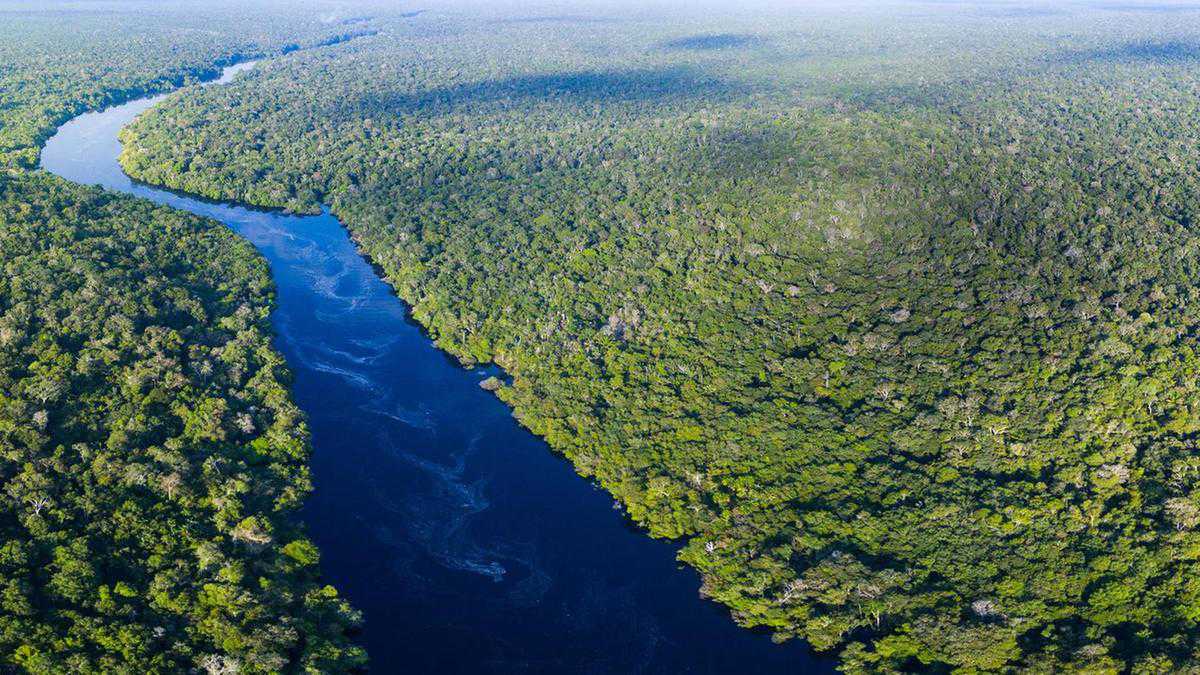Brazil’s best-kept secret: a night in the Amazon rainforest
19 March, 2019

The croak of a tree frog echoes in the air. I hear it, but only barely, so lost is it in the amplified hum of the rainforest’s cicadas. Famous for their drone, these insects can create sounds in excess of 90 decibels – that’s louder than the whirr of a motorbike. As we trek through the rainforest, deep in the Brazilian Amazon, the din dips and peaks, mixing with the rush of a nearby river or a twisting squawk from a tree-perched macaw. The whistle of the wind through millions of fluttering leaves is the underlying bassline for these rainforest soundmakers.
Suddenly, Samuel – our jungle guide – stops, signalling with his hand for us to do the same. He looks around, his eyes darting from side to side, his body almost motionless. Slowly, he raises his head, pointing his nose in the air. He inhales deeply. “Can you smell it?” he whispers. I sniff the air. It’s a balance of damp soil, rotting plants, wet tree bark and pollen-filled tropical flowers. But I don’t detect anything different.
Samuel nods his head in a northerly direction. I try again, focusing my nostrils to where he’d alluded. I inhale deeply. Nothing. I look to the others in my group and am relieved to see they’re also sniffing bewilderedly. Samuel shrugs, as if he cannot comprehend our inability to detect the change in the air, and whispers one word: “Jaguar.”
At once, I’m both thrilled and terrified. My eyes scan the foliage-sodden ground, although I quickly realise this is futile – Samuel’s trained eye would spot any trace of an animal long before my dulled western senses would. As a second-generation descendent of an indigenous Amazonian tribe, Samuel is in awe of the largest of South America’s big cats, and it’s no wonder. The creature’s bite is deadly – its jaws can slice straight through bones. Just a few days previously, he’d told us about a distant relative who had been taken in the night by a prowling jaguar.
Jaguar versus human
“We didn’t try to kill it for revenge,” Samuel explains. “We respect the jaguar, so instead we hunted other animals, a boar and a capybara. Then we offered these to it in exchange for the bones of our friend.” In the jungle, jaguar trumps human.
A chill goes through me as I hear something move a few metres away. But as quickly as Samuel’s mood had altered, it switches back – the threat of the jungle cat apparently having passed. He takes a machete from his belt and hacks at a branch snaking across the floor in front of us. He grabs one side of the chopped tree, then tells me to open my mouth. I oblige and he tips the narrow edge towards my lips. Cold, fresh sap rushes on to my tongue. It is much appreciated. The humidity in the rainforest is stifling, and my bottle of water has long been emptied.
Samuel explains that the branch is in fact a root belonging to a Sumaumeira, the tallest of all the rainforest’s trees. Chopping it precisely where he did means that the tree root will seal itself off and, within a few weeks, another offshoot will have sprouted, without any impact on the tree itself.
We continue our trek, quieter now – perhaps conscious of a looming jaguar. Occasionally we slow down, stopping to watch Samuel craft a spear from a tree branch (“perfect for catching armadillo”) or wind a rope out of the internal bark of a tree (“for hoisting things into the trees at night”). At our last stopping point, he somehow creates a working bow and arrow that stands about a metre tall. “No need to worry about the jaguar now,” he jokes before adding, “No, but this would catch a paca rodent – they taste like chicken but fattier, tastier.”
Setting up camp
About an hour later, we clamber around an embankment and hear the rush of running water. We’re back at base camp. When we’d arrived at the clearing just a few hours previously, that’s all it had been – a scrap of jungle plain worn flat by years of river overflow and home to just a couple of palm trees. Remarkably, it now resembles a fully functioning jungle camp.
Using those trees as a base, the Amazon Emotions team had crafted a structure out of ipe wood. On this, seven hammocks were hung. Double-layered giant philodendron leaves had been draped across the top of the branches to act as rain shelters. In the centre, a table for barbecuing on had been fashioned out of wood salvaged from the jungle floor. Underneath it, a fire glowed orange. On top of the table, two giant tambaqui fish were already roasting, recently speared out of the river.
As dinner cooks, we make for the river, strip off our rain-soaked jackets and plunge into the cold Amazonian water. I lay back on a rock, dipping my sweat-soaked hair into the river below. As the cool water rushes over my ears, the din of the jungle melts to a hazy drone and I look up.
